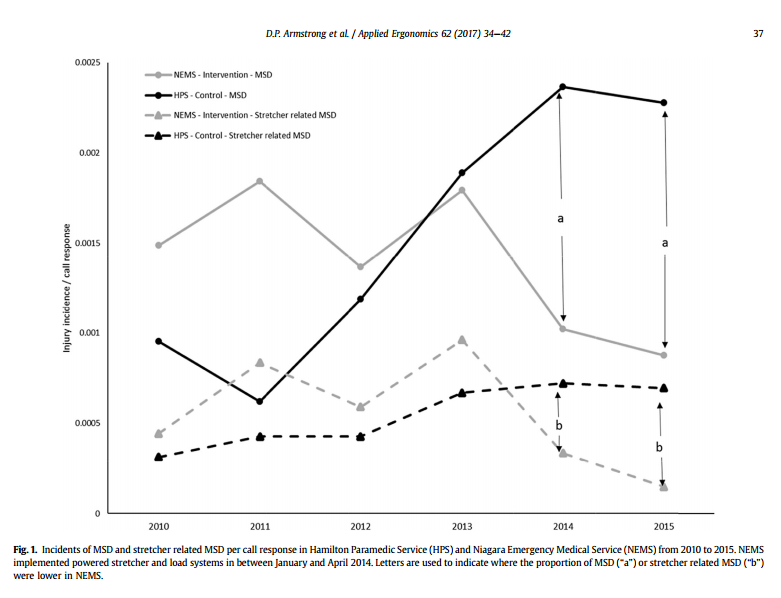An academic study lead by a University of Waterloo graduate student shows powered stretcher and load systems significantly decrease stretcher-related musculoskeletal injuries among paramedics, and the increased capital costs of power stretchers can be expected to be fully recovered over a seven-year period.
The study, published in Applied Ergonomics, compared musculoskeletal injuries between Niagara Region paramedics and the Hamilton Paramedic Service over a five year period.
The study found a “significant” decrease in stretcher-related musculoskeletal injuries by 78% among Niagara paramedics in the first year of power stretcher deployment. Overall, in that first year, musculoskeletal injuries decreased 53%.

The researchers compared injury rates of Niagara paramedics to Hamilton’s paramedics. Hamilton paramedics did not get power stretchers until late 2015. As shown in the figure above, the difference between injury rates in Niagara and Hamilton was stark. Hamilton’s injury rates continued to increase while Niagara’s decreased in 2015.
The researchers write:
The similarity of MSD and stretcher related MSD incidence between the two services and the significant differences observed post-intervention within the intervention group only strongly supports the effectiveness of the powered stretcher and load system as a viable intervention to reduce stretcher related MSD in a paramedic service.
Paramedics are increasingly challenged by increased rates of obesity among the population. In addition to patient weight, stretchers themselves add to the overall weight a team of two paramedics must lift when transporting a patient.
The researchers state:
Traditionally, stretchers have been manually operated by a team consisting of two paramedics. Stretchers are operated to: lower or raise the cot surface to facilitate patient transfer, transport, or repositioning; push or pull the stretcher while transporting a patient from the scene to the rear of the ambulance or from the ambulance into a hospital; and, to load and unload the stretcher into and out of the rear of the ambulance. The physical exposures to these activities, considering trunk strength and spine compression are high, in some cases described as exceeding well-established threshold limit values such as the NIOSH [CDC – The National Institute for Occupational Safety and Health] action limit for spine compression
Hamilton Implementing Power Stretchers
On May 25, 2015, Hamilton City Council’s Emergency and Community Services Committee voted to approve the purchase of power stretchers for Hamilton’s fleet of ambulances. (VIDEO of discussion and vote)
The Public Record emailed City staff requesting an update on the implementation of power stretchers
Hamilton’s Chief Paramedic told Councillors the implementation of the systems would result in cost-savings from decreased injury costs among paramedics. During the May 2015 debate, Councillor Tom Jackson expressed some concerned that Council is often told there will be cost-savings, but the savings do not materialize.
The research paper states the Niagara experience shows the costs of purchasing more expensive power stretchers is recovered over a seven-year period from decreased injury costs.
Our cost-benefit analyses revealed that the added
costs associated with a powered stretcher and load system intervention would be completely recovered within the stated 7-year service life of the system. Perhaps, more importantly, when replacing powered stretcher and load systems after the 7-year service life cycle, the return on investment is likely to improve as employee training is no longer a requirement.
The study ends by noting the need for further monitoring of power stretcher use to watch for new injuries resulting from increased stretcher weight in non-powered use:
The power stretchers were over 25 kg heavier than the manual stretchers previously used within the service, which may result in increased forces when pushing or pulling the stretcher or when boosting it up and over a small obstruction, such as a curb. The reported injury data did not permit us to drill down on specific activities that may have led to a stretcher related MSD, but given the increased weight of the powered stretcher, this may be important to monitor in the future.

